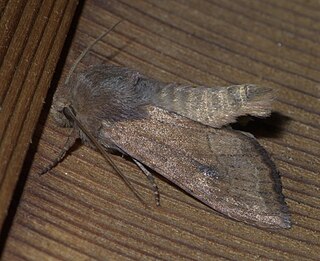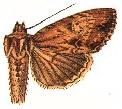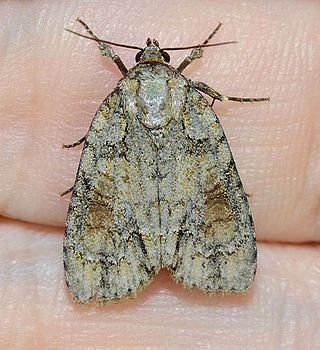
Acronicta is a genus of noctuid moths containing about 150 species distributed mainly in the temperate Holarctic, with some in adjacent subtropical regions. The genus was erected by Carl Linnaeus in his 1758 10th edition of Systema Naturae. Caterpillars of most Acronicta species are unmistakable, with brightly colored hairy spikes, and often feed quite visibly on common foliate trees. The hairy spikes may contain poison, which cause itchy, painful, swollen rash in humans on contact. The larva of the smeared dagger moth is unusually hairy even for this genus. Acronicta species are generally known as dagger moths, as most have one or more black dagger-shaped markings on their forewing uppersides. But some species have a conspicuous dark ring marking instead.

Apamea is a genus of moths in the family Noctuidae first described by Ferdinand Ochsenheimer in 1816.

Acronicta lithospila, the streaked dagger moth, is a moth of the family Noctuidae described by Augustus Radcliffe Grote in 1874. It is found in Canada and the United States.

Acronicta hamamelis, the witch hazel dagger moth or puzzling dagger moth, is a moth of the family Noctuidae. The species was first described by Achille Guenée in 1852. It is found in Canada and parts of the United States, including Maryland.

Acronicta spinigera, the nondescript dagger moth, is a species of moth of the family Noctuidae. It is found in southeastern Canada and the eastern United States.

Apamea inficita, the lined Quaker is a moth of the family Noctuidae. The species was first described by Francis Walker in 1857. It is native to North America, where it can be found from Newfoundland west to British Columbia, north to the Yukon and the Northwest Territories, and south to Colorado.
Apamea longula is a moth of the family Noctuidae first described by Augustus Radcliffe Grote in 1879. It is found in western North America, mostly from California to the Great Plains. There are also a few records from areas north, including Alberta, Yukon, and Alaska.

Apamea apamiformis, known by the common names rice worm moth, riceworm, and wild rice worm, is a moth of the family Noctuidae. It is found in North America, including Wisconsin, New York, Minnesota and eastern Canada, with imperiled or critically imperiled populations in Maryland and Indiana, respectively, and a vulnerable population in New Jersey.

Acronicta modica, the hesitant dagger, is a moth of the family Noctuidae. It is found in eastern North America from Nova Scotia to Florida, west to Oklahoma and Texas.

Apamea cristata is a moth of the family Noctuidae. It is found in the northeastern United States, including Michigan, New Hampshire, Maryland, New York, and Pennsylvania. In Canada it is found in Quebec and New Brunswick.
Apamea lutosa, the opalescent apamea, is a moth of the family Noctuidae. It is found in the northeastern United States, including New York and Indiana. In Canada it is found in Ontario, Quebec, British Columbia, Saskatchewan and Manitoba.
The coastal plain apamea is a moth of the family Noctuidae. It is found in scattered populations from Ontario, Quebec, New Brunswick, Nova Scotia and Manitoba in Canada south along the coast to New Jersey and North Carolina. Also inland in New York and western Maryland. It has also been reported from Massachusetts, Maine, Michigan and Ohio.

Apamea vulgaris is a moth of the family Noctuidae. It is found from Nova Scotia to Kentucky, and west to Kansas. It has been recorded from Ontario, New York, Pennsylvania and Maryland.

Apamea genialis is a moth of the family Noctuidae. It is found in North America.

Apamea indocilis, the ignorant apamea, is a moth of the family Noctuidae. It is native to North America, where it is distributed throughout southern Canada and the northern United States. In the east its range extends from Newfoundland to South Carolina. In the west it occurs as far south as San Francisco Bay and in the Rocky Mountains to New Mexico.

Acronicta exilis, the exiled dagger moth, is a moth of the family Noctuidae. The species is found in North America, including Iowa, New York, Maryland Arkansas and Delaware.
Omphalocera cariosa is a species of snout moth, and the type species in the genus Omphalocera. It was described by Julius Lederer in 1863. It is found from North America to Brazil.
Pterotaea cariosa is a species of geometrid moth in the family Geometridae. It is found in North America.






